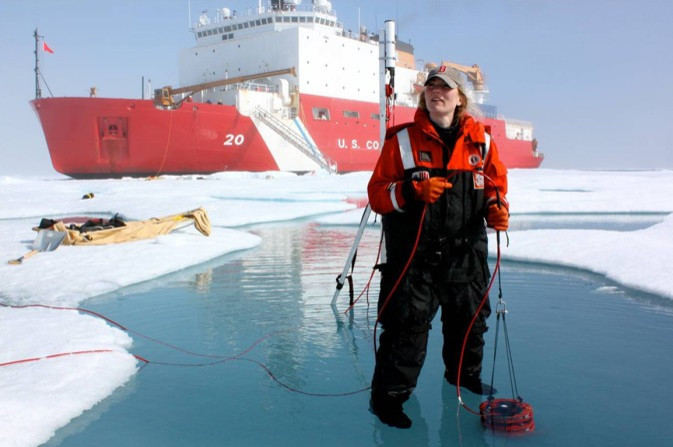Arctic Sea Bursting With Unexpected Life

Underneath the Arctic ice, scientists were expecting to find a relatively lifeless void - but instead discovered the most massive bloom of microscopic plant life they'd ever seen.
Miniscule creatures called phytoplankton are the foundation of the marine food web, providing sustenance for birds, fish, and even whales. Like plants on land, they require sunlight and certain nutrients nitrogen and phosphorus to survive.
Scientists had thought that these creatures could only thrive once the sea ice began to fully retreat, since the ice reflects most of the sunlight. But whereas 30 years ago, much of the sea ice in the Arctic was several years old and typically 10 feet thick, much of the sea ice in the Arctic today is younger and thinner. As this thinner ice melts, it forms shallow pools called meltponds that act like windows, allowing more light to penetrate into the water.
Over the last decade, the rate of sea ice thinning has doubled over past decades. Most climate scientists attribute both the thinning and reduction of Arctic sea ice to climate change.
All that light, plus the massive amounts of nutrients carried up to the Arctic from the Pacific Ocean, is a recipe for the unprecedented phytoplankton bonanza described in a new study appearing in the journal Science on Thursday.
Scientists from the NASA-funded ICESCAPE expedition - short for Impacts of Climate on EcoSystems and Chemistry of the Arctic Pacific Environment - talked about the surprising find at a press conference on Thursday.
It was the most intense phytoplankton bloom I've ever seen in my 25 years of doing research, ICESCAPE lead and Stanford University oceanographer Kevin Arrigo said.
The ICESCAPE mission doesn't even know exactly how extensive the bloom is, but what they have measured is up to 30 meters (98 feet) deep and 100 kilometers (62 miles) across.
The phytoplankton the scientists found were growing at an astonishing rate, their numbers doubling more than once every day.
Though the find might raise hopes for the existence of microbial life under extraterrestrial ice - like the polar ice caps of Mars or Saturn's frozen moon Titan - ICESCAPE scientist Don Perovich, a visiting professor at the Dartmouth College Thayer School of Engineering in Dartmouth, N.H., seemed skeptical.
If you go out to the moons of Jupiter the ice is much, much thicker, and the light levels are several orders of magnitude smaller, Perovich explained.
The phytoplankton bloom does illuminate a massive shift in the Arctic ecosystem - one that may end up hurting migratory animals and other species that synch their life cycles to the timing of phytoplankton blooms.
As the ice gets thinner and the blooms happen earlier, the window of opportunity for those animals that feed on the plankton is also shifting, according to Arrigo.
There's a question of whether the animals going to be at the right place at the right time, Arrigo said.
SOURCE: Arrigo et al. Massive Phytoplankton Blooms Under Arctic Sea Ice. Science.
© Copyright IBTimes 2024. All rights reserved.





















